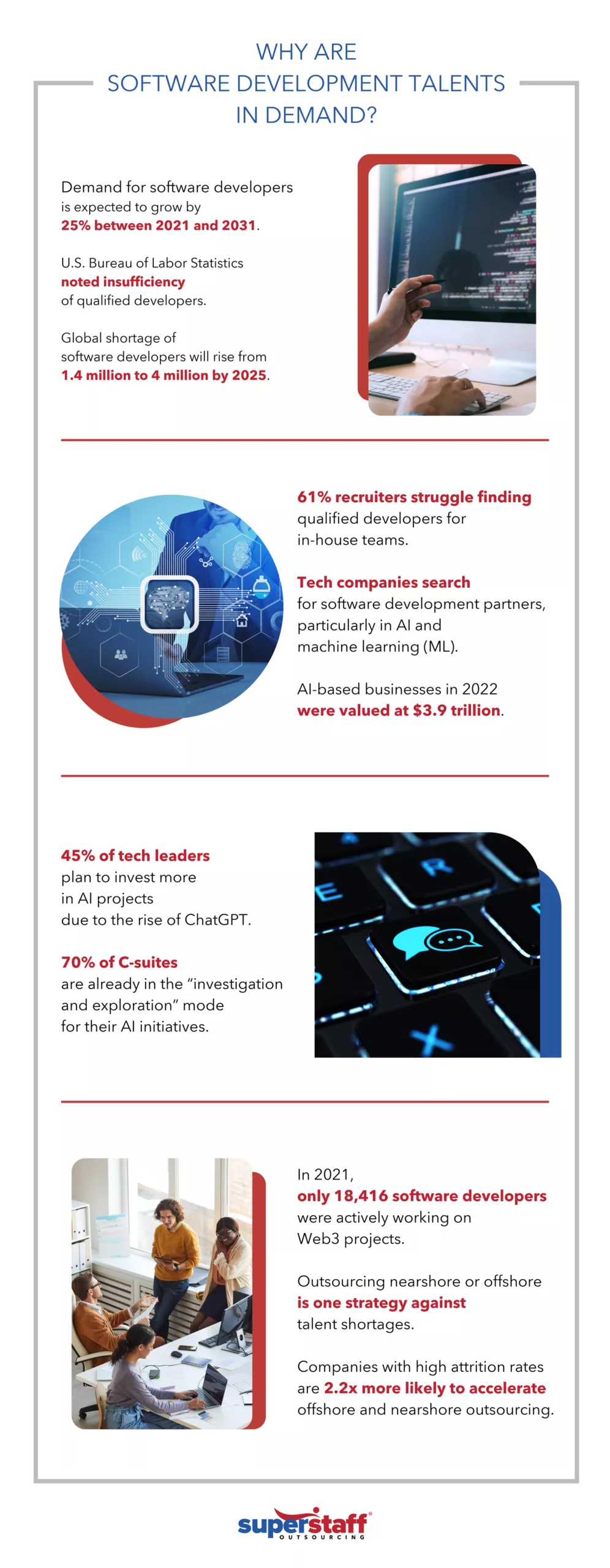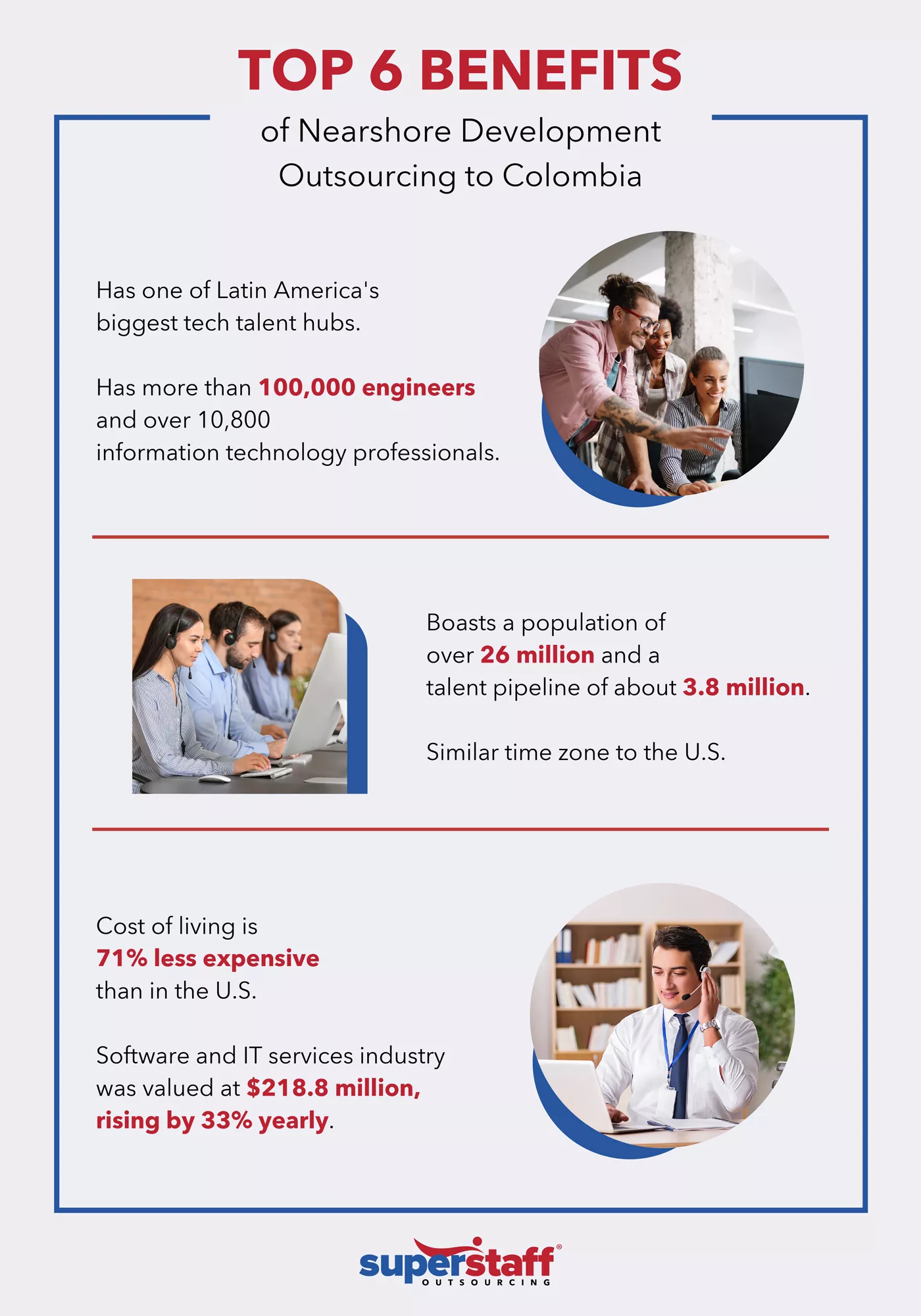
As businesses continue their race toward digital transformation and innovation, one major challenge stands in its way: the shortage of software developers and engineers.
Many tech companies are still struggling to find and recruit software developers and IT professionals with the skill sets and expertise they need for specific projects.
Even as news stories about recent layoffs in the tech industry dominate headlines, more businesses still face difficulties filling certain positions. Among the most in-demand (and most challenging to fill) roles in the tech sector include software developers, DevOps engineers, data analytics developers, and cybersecurity engineers.
Meanwhile, existing software developers are swamped with an overwhelming workload. While most collaborate with design teams, many say their time is spent chiefly on coding.
To lighten the workload of their software development team, companies are finding alternative solutions to the ongoing talent shortage: nearshore software development outsourcing.
In this article, we’ll take a closer look at the state of the U.S. software development talent crisis and discuss how outsourcing can help address this labor crunch. Then, we’ll cover which BPO location should be your ideal nearshoring destination.
State of the U.S. Software Development Talent Shortage in 2023

There continues to be a high demand for software development but a low supply of qualified developers and engineers.
For many industries, the effects of “The Great Resignation” are starting to slow down or disappear altogether. However, the tech sector still faces severe talent shortages, especially for software developers.
The demand for software developers is expected to grow by 25% between 2021 and 2031 – a growth that is much faster than the average for all occupations. However, the U.S. Bureau of Labor Statistics also notes that there might not be enough qualified developers to meet continually increasing demand.
A different study echoed these findings, predicting that the global shortage of software developers will rise from 1.4 million to 4 million by 2025.
As of 2023, more than half of HR professionals already struggle with recruiting qualified developers for their in-house team. To add insult to injury, digital workers say they plan to switch positions or jobs within two to three years, meaning the pool of qualified developers may get even smaller in just a few years.
Technology is innovating rapidly, but training and education aren’t keeping up.
The world of technology continues to evolve as new advancements like artificial intelligence (AI) and blockchain technologies dominate headlines around the globe. As much as businesses want to keep up with the latest innovations, most are having trouble finding the right software developers to help implement and integrate these technologies into their daily operations.
The Rise of AI Creates a Demand for Qualified Developers
As early as 2019, tech companies have been searching for software development partners with niche expertise and specializations, particularly in AI and machine learning (ML).
In fact, one report found that AI-based businesses in 2022 were valued at $3.9 trillion. In 2023, at least 70% of companies said they are exploring the uses of generative AI in their business processes.
Additionally, a recent Gartner poll surveying over 2,500 executives and business leaders found that 45% are planning to invest more in AI projects due to the rise of ChatGPT.
The same survey found that 70% of C-suites are already in the “investigation and exploration” mode in their AI initiatives, while 19% are already pilot-testing their AI software or are in production mode.
Web3 Growth Stalled By Software Developer Shortage
In addition to ChatGPT and other AI tools, blockchain technology is another innovation driving the increased demand for software developers. Many organizations, including tech and financial service institutions, advocate for the in-house development of Web3 projects, which aim to incorporate decentralized networks, cryptocurrencies, and other blockchain-powered innovations into the Internet.
However, one major challenge stands in the way of Web3’s advancement: a shortage of software developers and programmers knowledgeable about blockchain technology.
In 2021, only 18,416 software developers were actively working on Web3 projects. To illustrate how minuscule that number is, note that the total number of developers worldwide is 31.1 million.
According to a Forbes article, the main barrier keeping software developers from working on Web3 projects is because these require advanced knowledge of niche programming languages like Solidarity and Rust, as well as familiarity with Ethereum and Solana, which are brand-new technologies not commonly taught in universities or tech boot camps.
Organizations are searching for practical solutions to the talent crunch; Nearshore software outsourcing is emerging as a top strategic option.
To address the talent gap, some companies are choosing to invest in the training and development of their workforce. Businesses are encouraging their existing employees to upskill and take advantage of learning opportunities such as international assignments or skills training programs.
Here’s one real-life example: In 2022, Audi, the German automobile manufacturer, launched a digital skills training initiative for their workers, even allotting a €500 million budget. The goal is for Audi employees to be trained in software development, data analytics, systems engineering, and other in-demand tech skills.
Another example is the multinational tech and e-commerce giant Amazon, which offers self-directed online learning resources for its employees. These virtual training sessions give their workers extra credentials and skills at no additional cost.
In addition to investing in the training of their existing workers, companies are partnering with universities to fund scholarships, digital skills training, and student innovation programs for young tech-minded talents. For instance, Volkswagen is funding coding schools in Mexico and Brazil to bolster tech skills among students.
Software Development Outsourcing: The Present and Future Solution to Skill Shortages
Although training and education can help companies navigate the long-term effects of the talent shortage, what about businesses that don’t have the time or capability to train employees?
What about those who need qualified talents immediately or for time-sensitive, urgent projects and roles? This is where outsourcing comes in.
According to a Bain & Company 2023 report, outsourcing to a nearshore or offshore developer is one of the critical strategies businesses use to address talent shortages. In addition to delegating software development tasks to outsourced teams, they also need tech professionals with expertise in data analytics, cybersecurity, and the Internet of Things (IoT).
The same study found that companies facing high attrition rates among their in-house staff are 2.2x more likely to accelerate offshore and nearshore hiring for software engineering functions.
How Nearshore Development Outsourcing Helps Solve the Talent Crunch

Greater Access to Qualified Tech Talents
Instead of only considering tech talents within your country, consider expanding your search beyond your borders. Nearshoring allows you to access a much wider pool of qualified talents with the skills and expertise needed to facilitate your digital transformation initiatives.
U.S. businesses struggling to fill tech positions because of a scarcity of local talent have been setting their sights on Latin America. And one particular market many companies have been eyeing as a nearshore IT outsourcing location is Colombia.
Known as the Gateway to South America, Colombia has among the largest workforces in the region, boasting a population of over 26 million people and a talent pipeline of about 3.8 million university students.
Additionally, Colombia has one of Latin America’s biggest (and continually growing) tech talent hubs. As of 2023, the country has more than 100,000 engineers and over 10,800 information technology professionals, but industry experts expect this tech workforce to keep growing in the next few years.
Increased Flexibility and Scalability
According to a Gartner study, 64% of IT executives say that tech talent shortages keep them from taking advantage of technological innovations, particularly in software development, network security, and automation.
For this reason, many businesses are struggling to scale up their operations and take advantage of new opportunities and technologies. Thankfully, working with nearshore software development teams can help these companies fortify their scalability and achieve business growth by filling the gaps in their labor force and providing much-needed support for their core team.
Adopting a nearshoring strategy can also help businesses become more flexible by allowing their operations not to be tied to only one location, helping to minimize risks and future-proof their company in case of any market disruptions.
Compared to offshore locations, nearshore sites also offer the benefit of geographic proximity. So, despite being located away from your home country, you can retain control over your operations and easily collaborate with your BPO partner. Colombia, for instance, has a similar time zone to the U.S., allowing you to schedule meetings or trips without hassle.
Significant Cost Advantage
In addition to giving businesses greater access to tech talents and increased scalability, nearshoring can help them save on costs and improve their bottom line.
Let’s face it: Working with nearshore outsourced developers is significantly more cost-effective than hiring within the United States.
Take a look at Colombia, for instance. The median salary for U.S. software developers is $120,730. Meanwhile, the average annual salary in Colombia for the same role is $59,393.
The cost of living in this South American country is also 71% less expensive than in the U.S. Even wages, office space rentals, and other business expenses are considerably less costly.
If you want to minimize costs while still making sure that you’re working with world-class software development professionals, then nearshoring can be your best bet.
Why Colombia Is the Ideal Nearshore Software Development Outsourcing Destination
Colombia has one of the fastest-growing tech workforces in the world.
In previous sections, we mentioned Colombia has a massive tech workforce with over 100,000 engineers and 10,800 IT and software service professionals. We have yet to discuss how the South American country invests in digital skills education to further grow this already large labor force.
The biggest cities in Colombia, with Medellin, in particular, being eyed as the country’s main technology hub, house several top universities that offer high-quality information technology courses. Tech boot camps are also available for young professionals looking to develop crucial digital skills.
Through non-profits, more Colombian students can pursue educational opportunities and training that allow them to pursue careers in specialized fields such as software development.
Colombia is the top IT and tech services provider in Latin America.
Latin American countries have long been considered one of the top IT solutions providers since the 1980s. However, Colombia, in particular, is growing to be the most attractive outsourcing location in the region, especially for the IT and software development sector.
There’s a reason why Colombia is becoming known as the “Silicon Valley of Latin America.” The country’s IT sector accounts for over 10% of its economy, owing to significant foreign direct investment and tech-related exports.
In 2021, Colombia’s software and IT services industry was valued at $218.8 million, rising by 33% more than the previous year. Experts predict that the sector will continue growing and expanding–mainly as it invests in its human capital and technological infrastructure–throughout 2023 and beyond.
The Colombian government is continually investing in digital transformation to increase global competitiveness.
Suppose you’re still searching for reasons to nearshore to Colombia. In that case, you should know that the South American country’s government is creating policies that will make it easier for tech businesses and tech talents to become competitive in the global marketplace.
Since 2000, the Colombian government has been promoting digital transformation by publishing its Connectivity Agenda. In its national development plan, the government aimed to take a leading role in advancing the digitization and economic development of the country.
The two main points of the agenda included:
- Making broadband internet and digital infrastructure more accessible to the entire Colombian population; and
- Implementing disruptive technologies, such as AI, IoT, and blockchain, into their daily operations.
Through these digital transformation initiatives, companies who work with a Colombian software development company can access these same advanced technologies, helping accelerate innovation and business growth.
Partner With the Skilled Nearshore Software Developers at SuperStaff
If the software development talent shortage has been limiting your business capabilities, now’s the time to take action and address the problem head-on.
At SuperStaff, we offer nearshore software development outsourcing solutions that can help you navigate the talent crunch and accelerate your digital transformation initiatives. Our Colombian site is equipped with top-of-the-line tech infrastructure and features a wealth of qualified talents, ready to help you propel your company to new heights.
Connect with us, and let’s discuss what our nearshoring team can do for you!






